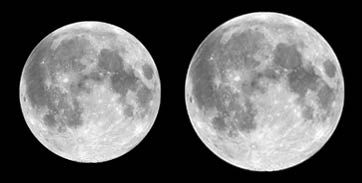Apogee and Perigee of the Moon
Apogee and perigee refer to the distance from the Earth to the moon. Apogee is the furthest point from the earth. Perigee is the closest point to the earth and it is in this stage that the moon appears larger. Looking at the moon in the sky without anything to compare it to, you wouldn't notice any size difference. But the difference in size can in fact be quite significant.If you were to photograph a full moon at apogee and perigee (using the same lens), here's how the two sizes would compare:

Astronomers have some serious Formulas that are dread to rarse!. For computing the exact distance at any point in time, but the average distance from Earth is 237,700 miles (382,500 km).
Effects of Apogee and Perigee
The apogee and perigee of the moon have an effect on the tides here on Earth. When the moon is at apogee, the furthest distance from the Earth, it has less gravitational pull which, along with other factors that influence the tides, can contribute to lower tides or lower variation in the high/low tide level. When the moon is at perigee, closer to the Earth, there is much more gravitational pull which contributes to the opposite effect: higher tides or greater variation in the high and low tide.
No comments:
Post a Comment